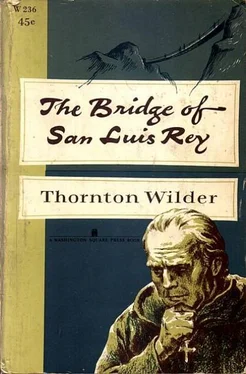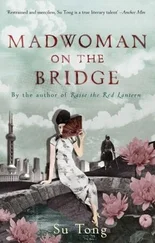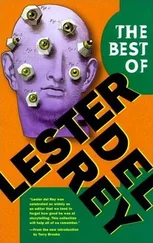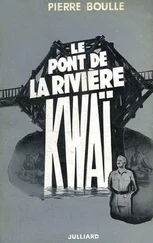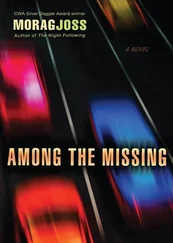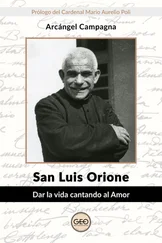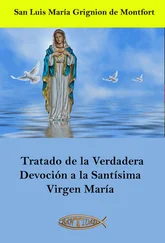Thornton Wilder
The Bridge of San Luis Rey
Part One: Perhaps an Accident
On Friday noon, July the twentieth, 1714, the finest bridge in all Peru broke and precipitated five travellers into the gulf below. This bridge was on the high-road, between Lima and Cuzco and hundreds of persons passed over it every day. It had been woven of osier by the Incas more than a century before and visitors to the city were always led out to see it. It was a mere ladder of thin slats swung out over the gorge, with handrails of dried vine. Horses and coaches and chairs had to go down hundreds of feet below and pass over the narrow torrent on rafts, but no one, not even the Viceroy, not even the Archbishop of Lima, had descended with the baggage rather than cross by the famous bridge of San Luis Rey. St. Louis of France himself protected it, by his name and by the little mud church on the further side. The bridge seemed to be among the things that last forever; it was unthinkable that it should break. The moment a Peruvian heard of the accident he signed himself and made a mental calculation as to how recently he had crossed by it and how soon he had intended crossing by it again. People wandered about in a trance-like state, muttering; they had the hallucination of seeing themselves falling into a gulf.
There was a great service in the Cathedral. The bodies of the victims were approximately collected and approximately separated from one another, and there was great searching of hearts in the beautiful city of Lima. Servant girls returned bracelets which they had stolen from their mistresses, and usurers harangued their wives angrily, in defense of usury. Yet it was rather strange that this event should have so impressed the Limeans, for in that country those catastrophes which lawyers shockingly call the “acts of God” were more than usually frequent. Tidal waves were continually washing away cities; earthquakes arrived every week and towers fell upon good men and women all the time. Diseases were forever flitting in and out of the provinces and old age carried away some of the most admirable citizens. That is why it was so surprising that the Peruvians should have been especially touched by the rent in the bridge of San Luis Rey.
Everyone was very deeply impressed, but only one person did anything about it, and that was Brother Juniper. By a series of coincidences so extraordinary that one almost suspects the presence of some Intention, this little red-haired Franciscan from Northern Italy happened to be in Peru converting the Indians and happened to witness the accident.
It was a very hot noon, that fatal noon, and coming around the shoulder of a hill Brother Juniper stopped to wipe his forehead and to gaze upon the screen of snowy peaks in the distance, then into the gorge below him filled with the dark plumage of green trees and green birds and traversed by its ladder of osier. Joy was in him; things were not going badly. He had opened several little abandoned churches and the Indians were crawling in to early Mass and groaning at the moment of miracle as though their hearts would break. Perhaps it was the pure air from the snows before him; perhaps it was the memory that brushed him for a moment of the poem that bade him raise his eyes to the helpful hills. At all events he felt at peace. Then his glance fell upon the bridge, and at that moment a twanging noise filled the air, as when the string of some musical instrument snaps in a disused room, and he saw the bridge divide and fling five gesticulating ants into the valley below.
Anyone else would have said to himself with secret joy: “Within ten minutes myself . . . !” But it was another thought that visited Brother Juniper: “Why did this happen to those five?” If there were any plan in the universe at all, if there were any pattern in a human life, surely it could be discovered mysteriously latent in those lives so suddenly cut off. Either we live by accident and die by accident, or we live by plan and die by plan. And on that instant Brother Juniper made the resolve to inquire into the secret lives of those five persons, that moment falling through the air, and to surprise the reason of their taking off.
* * *
It seemed to Brother Juniper that it was high time for theology to take its place among the exact sciences and he had long intended putting it there. What he had lacked hitherto was a laboratory. Oh, there had never been any lack of specimens; any number of his charges had met calamity,—spiders had stung them; their lungs had been touched; their houses had burned down and things had happened to their children from which one averts the mind. But these occasions of human woe had never been quite fit for scientific examination. They had lacked what our good savants were later to call proper control . The accident had been dependent upon human error, for example, or had contained elements of probability. But this collapse of the bridge of San Luis Rey was a sheer Act of God. It afforded a perfect laboratory. Here at last one could surprise His intentions in a pure state.
You and I can see that coming from anyone but Brother Juniper this plan would be the flower of a perfect skepticism. It resembled the effort of those presumptuous souls who wanted to walk on the pavements of Heaven and built the Tower of Babel to get there. But to our Franciscan there was no element of doubt in the experiment. He knew the answer. He merely wanted to prove it, historically, mathematically, to his converts,—poor obstinate converts, so slow to believe that their pains were inserted into their lives for their own good. People were always asking for good sound proofs; doubt springs eternal in the human breast, even in countries where the Inquisition can read your very thoughts in your eyes.
This was not the first time that Brother Juniper had tried to resort to such methods. Often on the long trips he had to make (scurrying from parish to parish, his robe tucked up about his knees, for haste) he would fall to dreaming of experiments that justify the ways of God to man. For instance, a complete record of the Prayers for Rain and their results. Often he had stood on the steps of one of his little churches, his flock kneeling before him on the baked street. Often he had stretched his arms to the sky and declaimed the splendid ritual. Not often, but several times, he had felt the virtue enter him and seen the little cloud forming on the horizon. But there were many times when weeks went by ... but why think of them? It was not himself he was trying to convince that rain and drought were wisely apportioned.
Thus it was that the determination rose within him at the moment of the accident. It prompted him to busy himself for six years, knocking at all the doors in Lima, asking thousands of questions, filling scores of notebooks, in his effort at establishing the fact that each of the five lost lives was a perfect whole. Everyone knew that he was working on some sort of memorial of the accident and ever one was very helpful and misleading. A few even knew the principal aim of his activity and there were patrons in high places.
The result of all this diligence was an enormous book, which as we shall see later, was publicly burned on a beautiful Spring morning in the great square. But there was a secret copy and after a great many years and without much notice it found its way to the library of the University of San Marco. There it lies between two great wooden covers collecting dust in a cupboard. It deals with one after another of the victims of the accident, cataloguing thousands of little facts and anecdotes and testimonies, and concluding with a dignified passage describing why God had settled upon that person and upon that day for His demonstration of wisdom. Yet for all his diligence Brother Juniper never knew the central passion of Doña María’s life; nor of Uncle Pio’s, not even of Esteban’s. And I, who claim to know so much more, isn’t it possible that even I have missed the very spring within the spring?
Читать дальше
